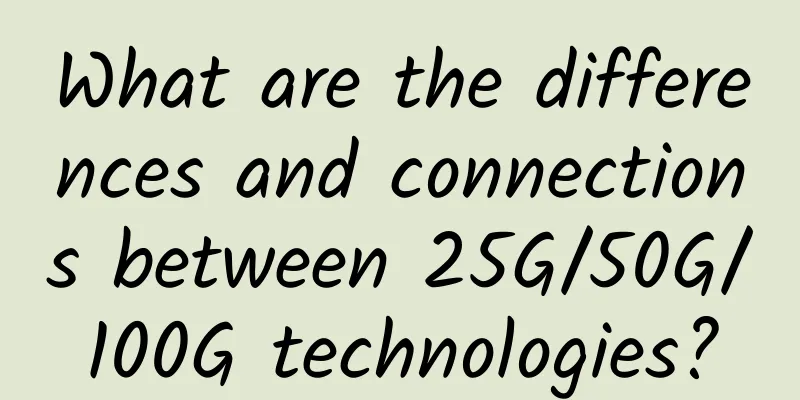What are the differences and connections between 25G/50G/100G technologies?

|
In the past decade, 10G and 40G technologies have occupied most of the Ethernet market. However, with the user's demand for high bandwidth and the development of special applications, 25G/50G/100G technologies are increasingly attracting users' attention. They gradually stand out in network deployment by providing effective paths for high rates. Below we will focus on 25G/50G/100G technologies and their relationship. 25G TechnologyThe 25G Ethernet standard was launched by IEEE in 2016 for servers in cloud data centers. This standard was launched several years later than the 10G/40G/100G Ethernet standards. The main advantage of 25G is the use of SerDes technology, which is a mainstream time division multiplexing (TDM), point-to-point (P2P) serial communication technology. It can make full use of the channel capacity of the transmission media and minimize the number of transmission channels and device pins required, thereby increasing the signal transmission rate and greatly reducing communication costs. Currently, most components used in switches run SerDes with a clock rate of about 10Ghz, which can provide a transmission rate of 10Gbps between different components. In recent years, due to the rapid development of SerDes technology, SerDes with a clock rate of 25Ghz has become one of the economically viable options, which has led to differences in cost and benefits between 10G and 40G and 25G. For example: 10G VS 25G: For the same SerDes channel, the throughput provided by 25G is 2.5 times higher than that provided by 10G. When the 10G network is upgraded to 25G, since the 25G SFP28 optical module can use the LC jumper used in the 10G network wiring, there is no need to re-wire, which can effectively save costs. 40G VS 25G: 40G uses four 10Gbps fiber channels (SerDes with a clock rate of 12.5Ghz), while 25G uses a single SerDes channel, so 25G can provide higher port density. At the same time, since most 40G QSFP+ optical modules on the market need to be used with MTP/MPO jumpers, 10G-40G will inevitably increase cable costs. 50G TechnologyWith the maturity of 25G technology and users' demand for higher speeds, the industry has strong expectations for 50G. In 2018, IEEE launched the 50G Ethernet standard with the same architecture as the 400G/200G Ethernet standard. This standard uses PAM4 technology to effectively improve bandwidth utilization efficiency and become the next high-speed connection solution for servers and data centers. Since 50G can reuse the 25G components in the existing 100G network, it can effectively reduce costs. At the same time, the cost of 50G is half of that of 40G, but its performance is improved by 25%. Since PAM4 technology maps pairs of bits into a single symbol, the total baud rate of each 50Gbit/s channel is 26.5625 Gbaud. 50Gbaud PAM4 can provide 100G transmission rate through a 1250 Gbaud architecture (only one laser is needed), which means that the transmission rate can be increased from 10Gbps to 100Gbps using one laser, a tenfold increase. Compared with the early NRZ technology, PAM4 technology can provide higher transmission efficiency at a lower cost, so it is widely used in high-speed signal interconnection. 100G Technology100G Ethernet was officially released in 2010. Later, in order to meet the needs of high speed, long distance and some special scenarios, the standard was changed on a large scale. Due to the continuous optimization of standards, the unification of technical solutions, the development of the industrial chain, and the higher transmission rate and longer transmission distance (using DWDM technology), 100G is gradually replacing 40G. 100G DWDM technology can achieve long-distance high-capacity signal transmission on a single wavelength, and is particularly suitable for high-speed optical communications. Among them, coherent CFP DWDM optical modules are particularly suitable for 100G metropolitan area networks (MANs) or data center interconnects (DCIs) up to 80 kilometers or ultra-long links with transmission distances exceeding 1,000 kilometers. Currently, super-100G DWDM technology has also been commercialized in DCI scenarios. In addition, in multi-rate and multi-protocol network situations (such as 10G/40G/100G Ethernet protocols and rates), the use of 100G and beyond 100G DWDM multiplexing transponders can effectively avoid the redesign and planning of network architecture. It can directly combine signals of different protocols and different rates into a single wavelength of up to 100G/200G/400G for transmission, providing a highly flexible and cost-effective solution. What is the relationship between 25G/50G/100G?Now 25G/50G/100G are widely used in cloud data centers, and if the three are combined, 10G-25G-50G-100G network upgrades can be achieved. Before the emergence of 25G and 50G, 100G network upgrades were achieved through 10G-40G-100G, but this method is inefficient and costly. In contrast, 25G is the most cost-effective solution for upgrading to 100G. If 25G is used for 100G network upgrade, it can be achieved by using spine-leaf architecture through 425G or 250G SerDes channels. In this way, 25G can achieve network upgrade based on the existing wiring infrastructure with its compatibility, providing higher transmission efficiency and performance while saving capital expenditure (CAPEX) and operating costs (OPEX). In summary, the 25G-50G-100G network upgrade path can reduce the unit bandwidth cost by making full use of the switch port functions, while laying the foundation for 200G and 400G network upgrades. SummarizeFrom the above, we can see that 25G/50G/100G can adapt well to the needs of the market and lead the industry trend. Compared with the earlier 10G/40G, 25G/50G/100G adopts advanced technology and has certain advantages in cost and performance. It is undoubtedly the most cost-effective solution at present. As the saying goes, where there is demand there is development. Ethernet technology will continue to develop under the increasingly higher network demands. Let us wait and see what will happen in the future. |
<<: A sensible network engineer should have learned to handle this kind of failure long ago.
>>: Seize the critical period for large-scale application of 5G
Recommend
With the support of "new infrastructure", 5G helps industrial Internet enter the fast lane
2020 is a year full of "dangers" and &q...
China's Ministry of Industry and Information Technology: 2017 marks the first year of large-scale commercial use of the Internet of Things
Since the international standards were finalized ...
Codebeamer: Next-generation ALM product, driving digital innovation in the manufacturing industry
The Internet of Everything, cloud computing, and ...
4G is still growing, and 5G is still a long way off
Recently, the Ministry of Industry and Informatio...
Three major development trends of outdoor wireless networks in 2021
As the extraordinary year of 2020 draws to a clos...
[Black Friday] ProfitServer Singapore/Germany/Netherlands/Spain VPS 50% off, unlimited traffic KVM monthly payment starts from $2.88
ProfitServer has launched a Black Friday promotio...
From IP to IP, let's talk about the "useless" knowledge in computer networks
Web development is inseparable from computer netw...
It shouldn’t just be the packages that are being pushed up for 5G
"The 4G package was inexplicably upgraded to...
Talk about the difference between continuous integration, continuous delivery, and continuous deployment
CI needs to have the following: Comprehensive aut...
The Ministry of Industry and Information Technology plans to speed up the network. How far are we from 5G and Gigabit?
[[182163]] On January 17, the Ministry of Industr...
Do enterprise networks need to be upgraded to IPv6? What preparations should be made?
After decades of development and application, the...
Banks jointly explore new driving forces for transformation in 2021: large banks are preparing for qualitative changes while small banks are bridging the digital divide
In 2021, my country's "14th Five-Year Pl...
What do I think Web3 is? Let me tell you!
When it comes to web3, many people think it is a ...
IDC: Global edge computing market will reach $250.6 billion in 2024
Industry data: Gartner conducted a survey and int...
Interviewer: How to close a TCP connection without killing the process?
Hello everyone, I am Xiaolin. A reader was asked ...









